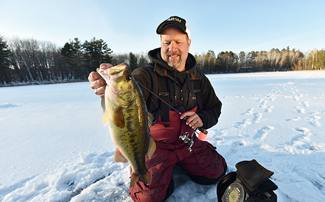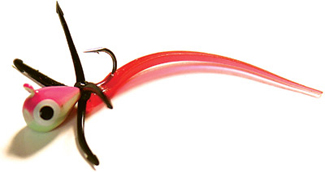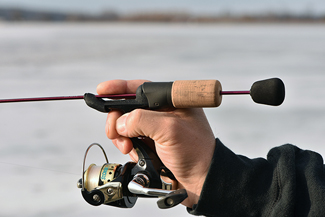 Editor's note: We usually write the product reviews, and we like our writing! But the below is from the company Traditions Media and promotes ice-fishing products. Even the article's links to web pages of tackle, including all of Frabill's tip-ups, might be interesting, at least. Here's the article: Editor's note: We usually write the product reviews, and we like our writing! But the below is from the company Traditions Media and promotes ice-fishing products. Even the article's links to web pages of tackle, including all of Frabill's tip-ups, might be interesting, at least. Here's the article:
Ice fishing for largemouth bass is sort of an economized version of its open-water counterpart.
Hobbit-sized rods.
Little bitty plastic worms. Micro hair jigs and small spoons. Even scaled-down ice crank baits. Each worked with utmost finesse, mesmerizing wintertime bass.
We say mesmerize because sometimes in freezing water, bass like to hover and stare things down for agonizing minutes at a time, before leisurely paddling off in the other direction, or finally, mercifully, opening up and eating.
Ice bass do head shakes in slow motion, so if you’re watching on an underwater camera, the sluggish drama looks particularly awesome.
All of which runs a little counter to what happens in waters hosting prodigious populations of largemouths or smallmouths.
Especially in ponds, lakes and reservoirs in the southern edge of the ice belt, bass often bite well all winter.
Meanwhile, peak fishing in northern natural lakes occurs at first and last ice.
That said, it’s feasible to find underwater havens with an Aqua-Vu camera -- sunken Christmas trees and other artificially placed cover -- that collect cadres of big bass all winter.
Put a lively golden shiner down there, and you’ll eventually catch every bass on the tree.
Rig a deadstick or Frabill Tip-Up and wait for flags to fly.
Hardwater Sight Fishing
Most of the rest of the time bass languish in water shallower than about 18 feet, and in many lakes, that means sight fishing near remnant veg beds.
Viewing through a “widescreen” hole, delivering baits to bass while sitting in a spacious shelter is a can’t-miss hardwater event.
Well worth the price of admission, sighting merely costs the effort to cut the crater, either by drilling a sequence of at least six holes in a rectangular shape, or by using a chainsaw or an Ice Saw.
For sight fishing individual big bass, I’m partial to tiny black marabou or fox hair jigs or 1- to 2-inch micro plastic worms.
 A little Wedgee Soft Bait is a bona fide bass catcher, when rigged on a No. 10 Custom Jigs Chekai Tungsten Jig. A little Wedgee Soft Bait is a bona fide bass catcher, when rigged on a No. 10 Custom Jigs Chekai Tungsten Jig.
It's even better if you skewer a Nucler Ant onto the jig first, followed by the Wedgee Worm.
That all creates the jig in the above photo.
Heavy-headed tungsten fishes fast, and exaggeratedly activates a thin plastic tail, even if you’re barely quivering the rod tip.
The trick is to keep the jighead relatively still while pulsing the tips of the plastic like it’s a little tense.
Best way to pull this off is to OD on coffee first thing in the morning.
Get your hands nice and shaky with a caffeine buzz -- that’s about the right jigging cadence for triggering coldwater bass.
Seriously, sometimes the best move of all is to simply keep the jig stock-still, giving quick, short hops every 10 seconds or so.
Again, watch each bass’s reaction on a camera to discover the best rhythm.
One slick soft bait alternative is a micro wacky rig.
Skewer the middle of a Custom Jigs Noodel -- essentially a micro wacky worm -- onto a tungsten shaky head (a No. 10 Majmun is perfect), and go to town.
Another option is a down-sized drop-shot rig, wielding the same micro soft baits on a different presentation, albeit in vertical fashion.
Same deal with bait moves as before. Take your time. Pause for painfully long seconds before giving the bait one or two tiny undulations. Pause again and wait.
No, really,wait! (Everything takes its time when the water’s 35-degrees.)
Hobbit Rods
All of these fine-tuned moves are best accomplished with, frankly, a fine-tuned ice rod.
You can’t believe how delicately bass can nip bitsy artificial things that fit into a contact lens.
It’s why whether you’re working a tiny tungsten jig and inch-long Wedgee plastic or a 1/16-ounce Slender Spoon, the right rod’s a big deal for hardwater bass.
St. Croix has borrowed the concept of a split grip handle from its Mojo Bass openwater rods and applied it to ice.
Wise move, dudes.
 Sensitivity reigns supreme at Croix, and the new Mojo ICE split grip ice rod, in the photo at left, sports an exposed blank, perfect for pencil-gripping with an index finger. Sensitivity reigns supreme at Croix, and the new Mojo ICE split grip ice rod, in the photo at left, sports an exposed blank, perfect for pencil-gripping with an index finger.
Grab a pair of fingerless gloves and catch the vibe.
A 32-inch medium Mojo Ice is just right for tungsten jigs and plastic, while the 36-inch MIR36L -- a lightweight gem of a rod -- is exceptional for working small hair jigs, spoons or down-sized swimming lures like Custom Jigs & Spins RPM (sort of a secret bass lure).
Spool with 4- or 5-pound test micro braid, such as PowerPro Ice Tec, and you’ll be fishing the most sensitive, fine-tuned bass instrument on the ice.
Bassin’ on ice remains sort of a cult-classic, almost like the behavior of the anti-establishment.
Few do it on purpose. Though no one really knows why.
But those who fish ‘em, release ‘em.
And if they happen across a pocket of smallmouths wintering in 25 feet of water, they move along and leave ‘em in peace.
Barotrauma’s a nasty business.
The rest of the time, bassin’ on ice is a beautiful wintertime behavior.
Think of it as fishing for members of the sunfish family, on a titanic scale. |
 Editor's note: We usually write the product reviews, and we like our writing! But the below is from the company Traditions Media and promotes ice-fishing products. Even the article's links to web pages of tackle, including all of Frabill's tip-ups, might be interesting, at least. Here's the article:
Editor's note: We usually write the product reviews, and we like our writing! But the below is from the company Traditions Media and promotes ice-fishing products. Even the article's links to web pages of tackle, including all of Frabill's tip-ups, might be interesting, at least. Here's the article: 

 A little
A little  Sensitivity reigns supreme at Croix, and the new
Sensitivity reigns supreme at Croix, and the new 
